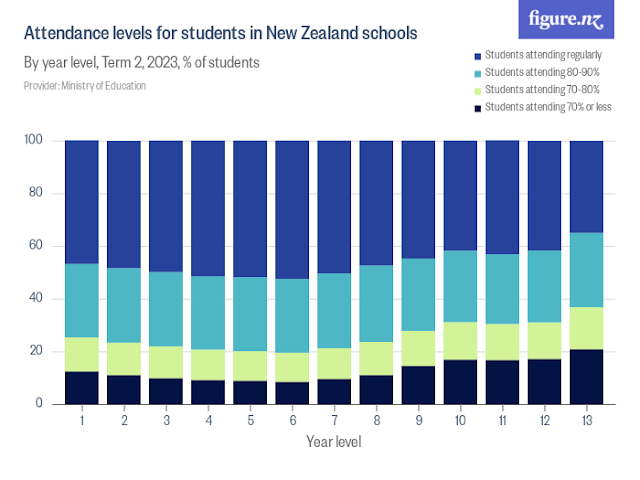Student Attendance - A Unique New Zealand Problem?
As teachers, we are acutely aware of the importance of student attendance for academic success and overall well-being. In recent times, the New Zealand government has taken a keen interest in this issue, acknowledging a concerning trend in declining school attendance rates. Prime Minister Christopher Luxon has set forth an ambitious goal to have 80% of students attend school for 90% of the term, highlighting the government’s commitment to reversing this downward trajectory. The government’s Attendance Action Plan emphasizes the significance of attendance and proposes initiatives to address the root causes of absenteeism. But is this absenteeism a local or global phenomenon? and how can it be solved?
Global Trends in Student Attendance
Globally, the picture of student attendance is complex and multifaceted. While there is a surge in demand for higher education, with projections of an additional one billion post-secondary graduates by 2050, the scenario at the primary and secondary levels presents a different challenge. Reports indicate that hundreds of millions of children worldwide do not attend school, with the COVID-19 pandemic exacerbating this issue. This decline is not limited to any single region but is a phenomenon observed across various continents and cultures.
Potential Causes for Declining Attendance
The decline in student attendance globally is a multifaceted issue that has garnered attention from teachers, policymakers, and researchers alike. Here’s an exploration of the different perspectives and a conclusion based on the available evidence.
Economic and Social Barriers Economic hardships and social barriers contribute to the decline in attendance. Challenges such as poverty, lack of transportation, and socioeconomic disadvantages can impede students’ ability to attend school regularly. Additionally, in a global context, fears of deportation, stigma, discrimination, and family separation can also affect attendance, particularly among marginalized communities.
Technological and Educational Shifts The advent of technology and the globalization of education have introduced new modes of learning that may impact traditional attendance patterns. Online learning platforms and alternative education models offer flexibility that can sometimes lead to decreased physical attendance in schools.
Curriculum and School Environment Some argue that the decline in attendance is due to an outdated curriculum and a school environment that fails to engage students. The lack of practical and creative activities, an overemphasis on examinations, and the prevalence of bullying and social media-induced stress can make the school experience unsatisfactory for many students.
Health Concerns Illness and family or home challenges, including trauma and housing issues, are also major drivers of chronic absenteeism. These obstacles can physically prevent students from getting to school.
Conclusion: Evidence-Based Actions
The evidence suggests student attendance is declining globally, with approximately 1 child in five worldwide not attending school. This issue disproportionately affects vulnerable student groups, who are often deliberately deprived of an education based on gender, disability, and ethnicity. Interventions that address these systemic barriers and provide support to students and families are modestly effective at boosting attendance. To address this, we must implement evidence-based strategies that consider the unique circumstances of each community. Some possible solutions are supported by evidence as illustrated below.
Breaking Down Barriers:
- Engage Families and Communities: Governments should collaborate with families, community organizations, and social services to address economic and social barriers. By involving parents and guardians, schools can create a supportive network that encourages regular attendance.
- Data-Driven Interventions: Schools can proactively identify absent students using data and connect them to resources. Early intervention helps prevent chronic absenteeism.
- Positive School Climate: Creating a positive and inclusive school environment fosters a sense of belonging. Students are more likely to attend when they feel safe and valued.
- Accommodate Health and Disability Needs: Ensuring equitable access to learning includes accommodating health conditions and disabilities. Schools should provide necessary support to students facing health challenges.
- Mental Health Services: Offering mental health support within schools can address emotional barriers and improve attendance.
Personalized Learning and Relationships:
- Schools focusing on building student engagement through relevant, personalized learning and strong teacher-student relationships experience fewer absences. When students find their interests and motivations catered to, attendance improves.
Well-Being Supports:
- Providing well-being services, including mental health support, addiction services, lunch programs, and identity-based clubs, can positively impact attendance. A holistic approach that addresses students’ overall well-being contributes to regular school attendance.
The New Zealand Government's approach to addressing absenteeism in schools attempts to tackle this now-recognised global phenomenon in several ways but still requires additional actions to increase its efficacy. By implementing these evidence-based strategies, the government can promote regular attendance and enhance student educational outcomes.
Engage Families and Communities:
- Support: The government has implemented a $40 million program to back local solutions led by schools and their communities. They collaborate with families, community organizations, and social services to address economic and social barriers.
- Action Needed: To further support this solution, the government should actively involve parents and guardians in creating a supportive network that encourages regular attendance. Schools can organize community engagement events and workshops to strengthen these connections.
Data-Driven Interventions:
- Support: The government has implemented new attendance officers who work with students having low or declining attendance rates. These officers proactively identify absent students and connect them to resources.
- Action Needed: To enhance data-driven interventions, the government should invest in better data collection systems and analytics tools. They should regularly analyze attendance data to identify trends and patterns, allowing for more targeted interventions.
Positive School Climate:
- Support: While not explicitly mentioned, creating a positive and inclusive school environment is essential for fostering a sense of belonging. Schools are encouraged to prioritize safety and value students’ well-being.
- Action Needed: The government should provide additional resources for schools to promote positive school climates. This could include training for teachers on creating inclusive classrooms and addressing bullying or discrimination.
Accommodate Health and Disability Needs:
- Support: The government acknowledges the importance of equitable access to learning. Schools are expected to accommodate health conditions and disabilities.
- Action Needed: To strengthen this support, the government should provide clear guidelines and funding for schools to implement necessary accommodations. Regular health assessments and individualized plans can help address specific student needs.
Mental Health Services:
- Support: While not explicitly mentioned, offering mental health support within schools is crucial for addressing emotional barriers and improving attendance.
- Action Needed: The government should allocate resources specifically for mental health services in schools. Trained counsellors and programs that promote emotional well-being can make a significant impact.
Personalized Learning and Relationships:
- Support: The government recognizes the importance of personalized learning and strong teacher-student relationships. Schools that focus on student engagement experience fewer absences.
- Action Needed: The government should provide professional development for teachers to enhance their ability to personalize learning. They should also promote student-centered teaching practices.
Well-Being Supports:
- Support: The government’s focus on overall well-being contributes to regular school attendance. Mental health support, addiction services, lunch programs, and identity-based clubs are part of this approach.
- Action Needed: To strengthen well-being support, the government should allocate additional funding for these services. They should also collaborate with community organizations to expand well-being programs beyond school hours.
In summary, the New Zealand Government has made significant efforts to address absenteeism, but there is room for improvement, especially around increasing rather than decreasing funding programmes that are shown to improve attendance. By continuing to collaborate with schools, families, and communities, they can create a more holistic approach to improve attendance rates. Regular monitoring, targeted interventions, and ongoing support are essential for achieving attendance targets.







Comments